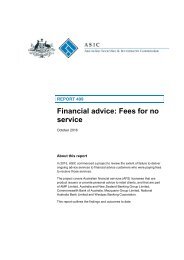statistics
2g0RSM6
2g0RSM6
Create successful ePaper yourself
Turn your PDF publications into a flip-book with our unique Google optimized e-Paper software.
Number of risks written is the number of risks written during the relevant period for direct business<br />
only. Where a policy covers multiple APRA classes of business and the premium is apportioned between<br />
these classes, one risk is reported in each APRA class of business to which premium was allocated. For<br />
example, a home and contents policy with a domestic liability component has premium allocated to<br />
both the householders class of business, and the public liability class of business. For this policy, one<br />
risk will be reported for the householders class of business, and one risk will be reported for the public<br />
liability class of business.<br />
Other assets comprises investment income receivable, other reinsurance assets receivable from<br />
reinsurers (i.e. other than reinsurance recoveries), GST receivable, other receivables, tax assets, plant<br />
and equipment (net of depreciation), derivative assets held at fair value (from March 2007 onwards due<br />
to AIFRS) and other assets.<br />
Other direct classes comprises aviation, consumer credit, marine, mortgage, other accident, travel<br />
and other classes of direct insurance business. For more details on the classes of business, please refer<br />
to the form instruction of GRF 310.1 Premium Revenue and Reinsurance Expense available on the APRA<br />
website.<br />
Other investments are strategic investments/acquisitions and other investments that do not constitute<br />
investments integral to insurance operations.<br />
Other items comprises other operating income and income tax expense or benefit (and goodwill<br />
amortisation in periods prior to March 2007).<br />
Other liabilities comprises creditors and accruals, other provisions, derivative liabilities held at fair<br />
value (from March 2007 onwards due to AIFRS) and other liabilities.<br />
Other operating expenses are all operating expenses not related to underwriting.<br />
Other underwriting expenses includes all other underwriting expenses which are not included in<br />
Acquisition costs (excluding LAT) or Commission expenses and are subject to deferral under AASB<br />
1023 .<br />
Outstanding claims liability is the insurer's liability for outstanding claims. It recognises the potential<br />
cost to the insurer of settling claims which it has incurred at the reporting date (including estimates of<br />
claims that have not yet been notified to the insurer), but which have not been paid. The amount<br />
reported is after taking account of inflation and discounting, without deducting reinsurance and nonreinsurance<br />
recoveries . Prior to September 2010, outstanding claims was reported under APRA's<br />
previous prospective reporting framework which required a minimum level of outstanding claims<br />
provision calculated in accordance with GPS 310 . Since September 2010, Outstanding claims liability is<br />
reported on an AASB 1023 basis, with any deficiency compared to amount calculated under a GPS 310<br />
basis deducted from capital.<br />
Outwards reinsurance expense is the total outwards reinsurance expense relating to current and prior<br />
years cover. Outwards reinsurance expense is recognised in accordance with the pattern of reinsurance<br />
service received as required by AASB 1023 .<br />
Operational risk charge is the minimum amount of capital required to be held against operational<br />
risks. The operational risk charge relates to the risk of loss resulting from inadequate or failed internal<br />
processes, people and systems or from external events.<br />
Payables on reinsurance contracts comprise amounts payable to reinsurers. This includes premiums<br />
payable but not yet due for payment, deposits withheld from reinsurers, commissions due to reinsurers<br />
and the reinsurers' portion of recoveries and salvage.<br />
Premium receivables are premiums due, net of provision for doubtful debts, including unclosed<br />
business written close to the reporting date.<br />
Australian Prudential Regulation Authority 29



